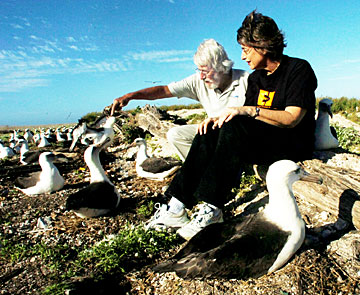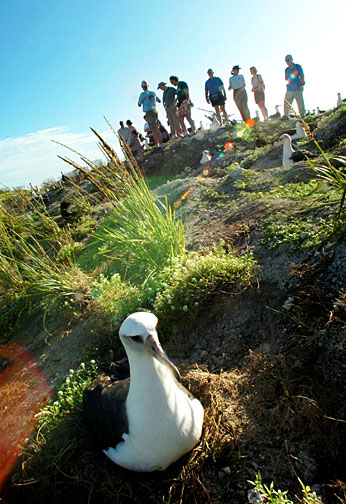
ASSOCIATED PRESS
Gov. Linda Lingle spoke with Jean-Michel Cousteau of the Ocean Futures Society on a visit Tuesday to Midway Atoll National Wildlife Refuge.
|
|
Lawmakers tour Northwestern atolls
Lingle, state and federal officials express amazement on their sanctuary fact-finding trip
By Tara Godvin
Associated Press
MIDWAY ATOLL » The air of this former military base is filled with birds' twittering, clacking, whistling and throaty sighs sounding like a bullfrog's call. The nests of albatrosses seem to cover every inch of open space.
Home to only a handful of voting residents but teeming with delicate and often endangered species on the land and in the surrounding ocean, the Northwestern Hawaiian Islands received a visit from Gov. Linda Lingle and a group of 13 other state and federal officials on Monday and Tuesday.
The trip was part of a push by Lingle to establish a sanctuary in the federal waters surrounding the islands and to keep Hawaii involved in the decision-making process.
In September, Lingle signed new rules banning fishing in the islands' state waters, which extend three miles out from the rocky, tiny isles dotting an isolated 1,200-mile stretch of ocean northwest of Kauai.
Lingle has been pushing for a similar ban for federal waters, which are currently protected as a coral reef ecosystem reserve and are in the process of becoming the nation's 14th marine sanctuary.
The islands themselves are already designated U.S. wildlife refuges -- one for the nine islands and atolls that fall within Hawaii borders and another for Midway Atoll, which is a federal possession.
During a swooping plane ride passing over several of the smaller islands and an overnight visit to Midway, officials who will have a hand in what management rules are put in place at the nascent sanctuary got firsthand experience of the astounding numbers of the area's creatures.

ASSOCIATED PRESS
A Laysan albatross sits on its nest while government and wildlife officials inspect Midway's Eastern Island.
|
|
"Until you come out and see it, you cannot imagine the geographic extent," said Jim Connaughton, chairman of the White House Council on Environmental Quality.
And much of that geography is below the surface of the ocean, he said.
A peek over the edge of a pier at Midway quickly put a look of gape-jawed shock on the face of Sen. Fred Hemmings, whose district encompasses the remote islands and who has been an advocate of their strict protection.
Swimming calmly below in the shallows was a school of hundreds of silvery moi, each about three times bigger than those normally seen in the waters surrounding the main Hawaiian islands.
"I think the fishermen in Hawaii would cry if they saw this," Hemmings said.
Handed over by the U.S. Navy to the U.S. Fish and Wildlife Service in 1996, Midway marks the spot where American dive bombers and fighter pilots turned the tide of World War II in the Pacific by fending off the Japanese naval fleet's attempt to secure the atoll.
Today, both the sea and the skies are teeming with life.
Snorkelers on the trip, including Lingle, discovered a reef crowded with swarms of different flitting fish.
The islands must be experienced to understand how intensely populated with creatures they are, said Peter Young, chairman of the state Board of Land and Natural Resources.
"And you can't simply say there are a lot of fish there. And you can't simply say there's a lot of monk seals and spinner dolphins and sea turtles and marine life and other species around, because the words don't give it justice about what is really there," Young said.

